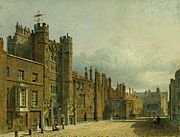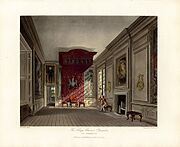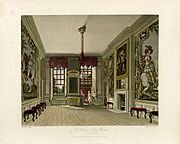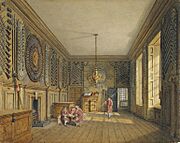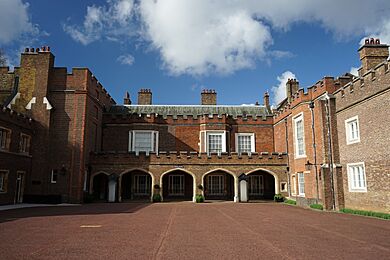St James's Palace facts for kids
Quick facts for kids St James's Palace |
|
|---|---|
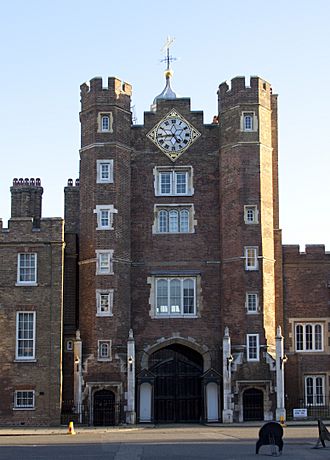
The north gatehouse, main entrance of St James's Palace in Pall Mall
|
|
| General information | |
| Architectural style | Tudor |
| Location | London, United Kingdom |
| Coordinates | 51°30′17″N 00°08′16″W / 51.50472°N 0.13778°W |
| Construction started | 1531 |
| Completed | 1536 |
| Client | Henry VIII |
| Owner | King Charles III in right of the Crown |
St James's Palace is a very important royal palace in London, the capital city of the United Kingdom. The palace gives its name to the Court of St James's, which is the King's official court. It is located in the City of Westminster in London.
Even though it is no longer the main home for the King or Queen, it is still used for important events. For example, it is where the Accession Council meets to officially announce a new monarch. It also houses the office of the Marshal of the Diplomatic Corps, which works with ambassadors. Several members of the royal family also live there.
King Henry VIII ordered the palace to be built in the 1530s. It was built where an old hospital for sick people used to be. For many years, St James's Palace was not as important as Whitehall Palace. It was often used as a hunting lodge or a quiet escape from busy court life. Sometimes, it was a guest house for royal visitors.
After Whitehall Palace was destroyed by fire, St James's Palace became the main place for royal business. It grew more important during the time of the Hanoverian kings and queens. However, Buckingham Palace started to become more important in the early 1800s. Queen Victoria made it official in 1837 that Buckingham Palace was the main royal home.
Today, St James's Palace has many royal offices and collections. All ambassadors and high commissioners from other countries still officially work with the 'Court of St James's' here. The palace's Chapel Royal is still used for royal family events. Important receptions are also often held at the palace.
The palace was mostly built between 1531 and 1536 using red brick. Its style is mainly Tudor. The Queen's Chapel was added in the 1620s. Clarence House was built next to the palace in the 1820s. A fire in 1809 destroyed parts of the palace, including the King's private rooms. These rooms were never rebuilt. Some parts from the 1600s still exist, but most were changed in the 1800s.
Contents
History of St James's Palace
Early Tudor Times
King Henry VIII ordered this palace to be built. It was on a quiet piece of land where an old hospital for people with leprosy used to be. The hospital was named after Saint James the Less. Henry VIII first used the palace as a hunting lodge for his new deer park, St. James's Park.
The new palace was built between 1531 and 1536. It was a smaller home where the King could relax away from the busy court life. St James's is much smaller than the nearby Whitehall Palace. It is built around four courtyards: the Colour Court, the Ambassador's Court, the Engine Court, and the Friary Court.
The most famous part of the palace is its north gatehouse. This gatehouse has four floors and two tall, round towers with castle-like tops. A clock on the top floor was added later, in 1731. The palace is decorated with the letters H.A. for Henry and his second wife, Anne Boleyn. Henry had the palace built with red bricks and darker bricks for details.
The palace was updated in 1544. Hans Holbein painted some of the ceilings. Two of Henry VIII's children, Henry FitzRoy, 1st Duke of Richmond and Somerset, and Mary I, died at St James's. Elizabeth I often stayed at the palace. She is said to have spent a night there waiting for the Spanish Armada to sail up the Channel.
Stuart Royal History

Prince Henry, the oldest son of King James, lived at St James's Palace until he died in 1612. The gardens were made better for him. A riding school, one of the first in England, was built for Henry at the palace between 1607 and 1609. He also had a library built there. Henry even kept a collection of pet birds, including ostriches.
Charles II was born at the palace on May 29, 1630. His parents were Charles I and Henrietta Maria. James II, Charles I's second son, was also born at the palace on October 14, 1633.
In 1638, Charles I gave the palace to Marie de Medici, Henrietta Maria's mother. Marie stayed for three years. However, having a Catholic former queen of France living there was not popular with the government. She was soon asked to leave. Charles I spent his last night at St James's before his execution. After that, Oliver Cromwell took over the palace and used it as army barracks.
Charles II restored the palace after the Commonwealth period ended. He also improved St James's Park. Mary II and Queen Anne were both born at the palace. In 1698, during the reign of William III, it became the main home for the King or Queen in London. This happened after Whitehall Palace was destroyed by fire. St James's Palace then became the main place for royal administration, a role it still partly has today.
Hanoverian Era and Changes
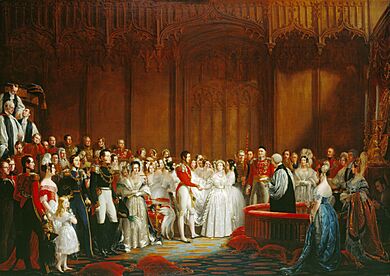
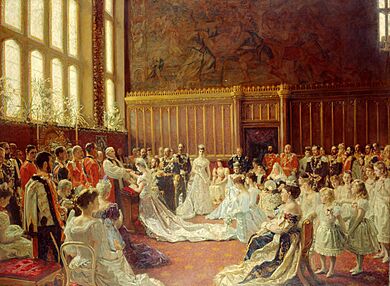
The first two kings from the House of Hanover, George I and George II, used St James's Palace as their main London home. In 1757, George II gave the palace library to the British Museum. This gift was the start of what later became the Royal Collection.
George III did not find St James's suitable. The old Tudor palace was seen as uncomfortable. Also, the area around it had become very built up, so it did not offer enough privacy for the royal family. In 1762, George III bought Buckingham House, which later became Buckingham Palace, for his queen, Charlotte of Mecklenburg-Strelitz.
In 1809, a fire destroyed part of St James's Palace. This included the King's private rooms. These rooms were never rebuilt. This left the Queen's Chapel separate from the rest of the palace. The royal family started spending most of their time at Buckingham House. St James's was then used only for formal events.
The last king to live at St James's, at least part of the year, was William IV. He had built Clarence House nearby and connected it to the palace. Queen Victoria made it official in 1837 that St James's was no longer the main royal residence. However, Victoria married her husband, Prince Albert, there in 1840.
20th Century Events
In 1912–1913, the palace hosted a meeting that led to a treaty between the Balkan states and Turkey. This followed two Balkan Wars. Edward VIII, when he was Prince of Wales, used the palace as his London home. George VI also lived there before he got married in 1923.
The Second Round Table Conference, about Indian independence, was held at the palace in 1931. On June 12, 1941, representatives from many countries met at the palace. They signed the Declaration of St James's Palace. This was one of the first steps that led to the creation of the United Nations.
The Proclamation Gallery
The Proclamation Gallery is a special part of St James's Palace. It is used after a King or Queen dies. The Accession Council meets there to declare the new monarch. Once the new monarch makes an oath, the Garter King of Arms steps onto the Proclamation Gallery. This gallery looks over Friary Court. From there, he officially announces the new King or Queen to the public. This last happened on September 10, 2022, when King Charles III was proclaimed.
St James's Palace Today
St James's Palace is still a working palace today. The Royal Court is still officially based there, even though the King or Queen lives elsewhere. It is also the London home of Princess Anne, Princess Beatrice, and Princess Alexandra.
The palace is used to host official receptions. For example, it hosts visiting heads of state. It also hosts events for charities that members of the royal family support. The palace is part of a larger group of buildings that hold royal offices and apartments for officials.
The palace complex includes York House. This was once the home of Charles III and his sons, Princes William and Harry. Lancaster House, located next door, is used by the UK Government for official receptions. The attached Clarence House, which was the home of the Queen Mother, is now the residence of King Charles III and Queen Camilla.
The nearby Queen's Chapel, built by Inigo Jones, is still considered part of the Palace. While the Queen's Chapel is sometimes open to the public, the Chapel Royal inside the palace is not. Both chapels are still active places of worship.
Many important royal offices are located at St James's Palace. These include the Royal Collection Department and the offices for the Marshal of the Diplomatic Corps. Since the early 2000s, the Royal Philatelic Collection (a collection of stamps) has been housed at St James's Palace.
Since June 1, 2007, the palace and its surrounding buildings have been a protected site. This means it is a crime for someone to trespass onto the site without permission.
Additional Reading
- Wolf Burchard, 'St James's Palace: George II and Queen Caroline's Principal London Residence', The Court Historian (2011), pp. 177–203.
- Nikolaus Pevsner, The Buildings of England: London 6: Westminster (2003), pp 594–601
See also
 In Spanish: Palacio de St. James para niños
In Spanish: Palacio de St. James para niños


